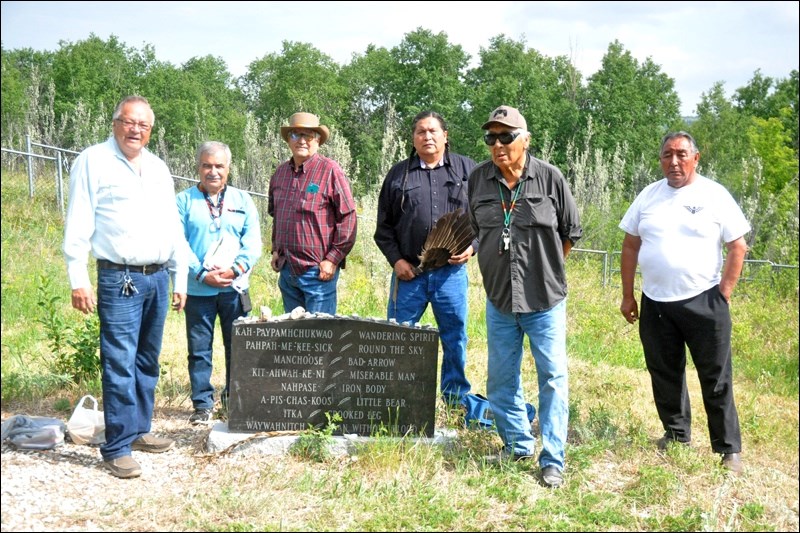A traditional gathering took place Saturday at the gravesite of the eight Indigenous warriors hanged at Battleford in 1885.
Several elders and members of surrounding First Nations were there for the ceremony remembering the warriors. The event included a pipe ceremony and prayers for those who had died as well as a ceremonial feast. It took place in Battleford at the burial site and memorial commemorating Kah - Paypamahchukways (Wandering Spirit), Pah Pah-Me-Kee-Sick (Walking the Sky), Manchoose (Bad Arrow), Kit-Ahwah-Ke-Ni (Miserable Man), Nahpase (Iron Body), A-Pis-Chas-Koos (Little Bear), Itka (Crooked Leg) and Waywahnitch (Man Without Blood).
“Our people have never forgotten these people. They got hung November 27, 1885,” said Brian Tootoosis, who is co-ordinator and liaison between Parks Canada and First Nations in the area.
“We are all related, all the First Nations in the Battlefords are absolutely related to all these people that got hung. So we pray with them, we eat with them to let them know we haven’t forgotten them as a people. They’re Cree people, they’re Assiniboine people, they fought for a cause, they thought about their people, they thought about survival when it was starvation. The government did the best they can to suppress and terminate these people. If they would have succeeded, there would have been no First Nations people, I guess, across the country. But you know, the Great Spirit has its ways of allowing our people to survive.”
The gathering followed a strict protocol that has stood the test of time.
“As protocol, most tribes have memorial events, memorial ceremonies,” said Eric Tootoosis of Poundmaker.
“For us, as original people, as per after the Ice Age, protocols were predetermined for us. And this is one of them that came, to remember our loved ones after they passed on. Most tribes have four ceremonies every year.”
“We always do this, this kind of pipe ceremony and feast for our people that have passed on,” said Edward Osecap, an elder from Moosomin.
“This is the only way we help our people that have gone.”
Kenneth Armstrong, an elder from Mosquito, said the significance of the ceremony enlightened his life, in his words. While growing up, his father and grandfather would talk about what had happened in the past.
“They would remember two of our people that were hung here back in the day. One of them was an older guy and the other one was a younger guy, they say. It’s really humbling to be here, and to be part of this pipe ceremony for our young people so that our young people should know our history, where we came from, and what we have to do to keep our culture together. And to make things right and to do these ceremonies, because our loved ones that have gone ahead are not forgotten.”
While this was a traditional Indigenous gathering, non-Indigenous visitors were invited to participate. One was the News-Optimist and the other was Nassy Fesharaki, a researcher who has taken deep interest in the life of Wandering Spirit.
This ceremony takes place every year at this same time before the National Indigenous Peoples Day on June 21.
A number of events are planned for the Battlefords and area both to celebrate Indigenous people, and also educate and bring broader awareness about their culture, traditions and history. Events are planned for downtown North Battleford as well as at Fort Battleford.
“We’re telling the truth, and we are going to educate the Canadian people about what happened in the Battlefords,” Brian Tootoosis said.



